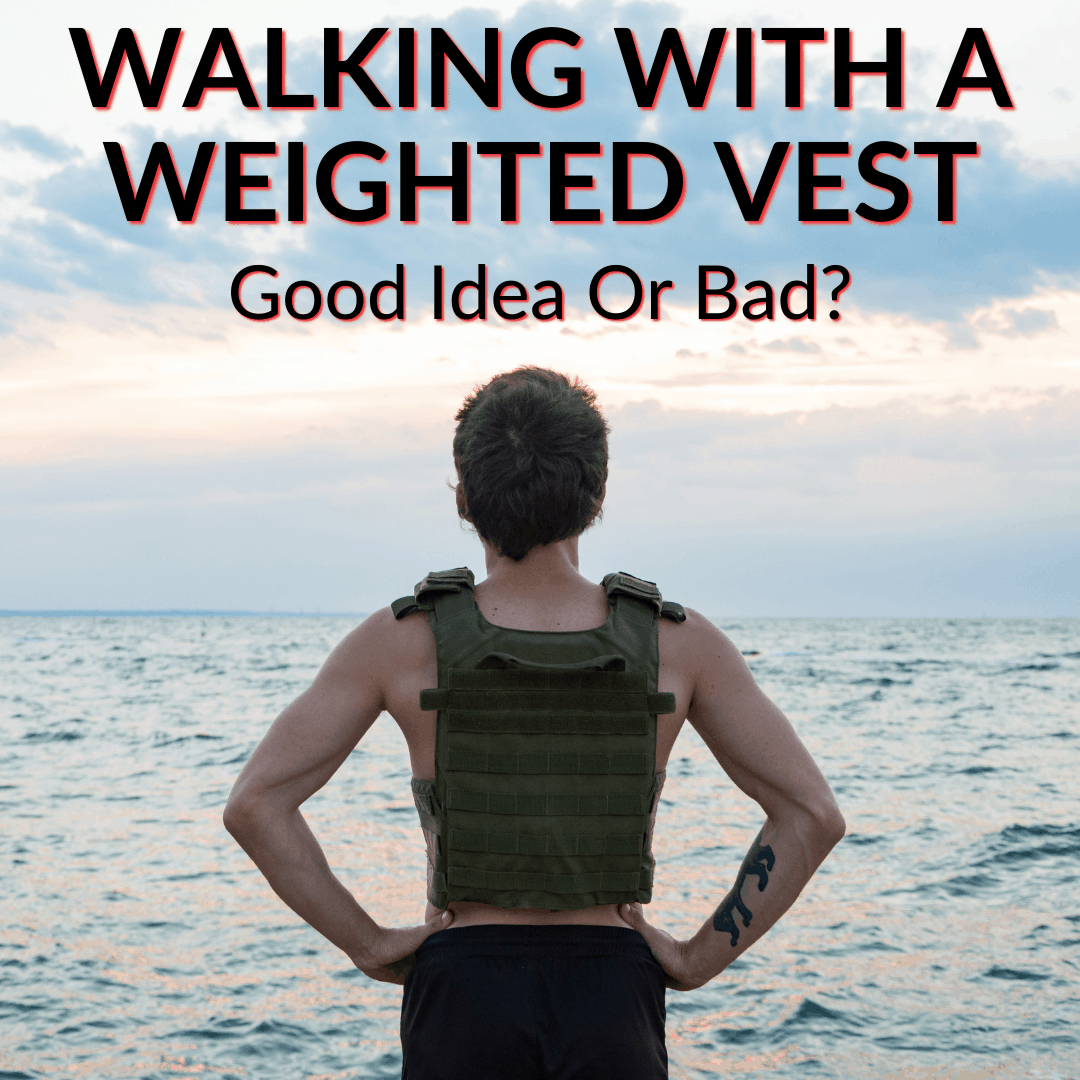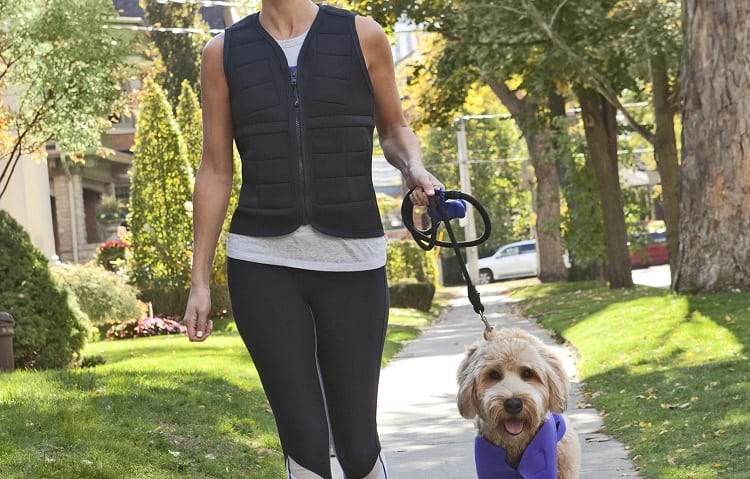 Weighted vests increase the resistance of body weight exercises.
Weighted vests increase the resistance of body weight exercises.
You’ll see people wear them to do pushups, pull ups and similar exercises. They are also commonly used when running.
It only makes sense then, that walking with a weighted vest could also be beneficial.
If you’re walking anyway, why not add some resistance and boost the benefits you get from your walk?
In general, we say go ahead. But you do need to be careful. Weight vests can be dangerous, if not used correctly.
Keep reading to learn why you should, and why maybe you shouldn’t, wear a weighted vest while walking.
Table of Contents
Walking With Weighted Vest: Benefits And Dangers
Walking by itself is one of the best exercises you can do. Loaded down with the weights of a weighted vest, though?
Well, that has both benefits and potential problems. We’ll cover that all below. First let’s begin with a quick rundown of the primary benefits of walking. We’ll also mention which benefits are enhanced by a weight vest.
Benefits Of Walking

These are the benefits of walking with or without a weighted vest. We’ll mention whether a weight vest can give you a boost for each of the benefits listed.
Improved Circulation
When you move, you encourage blood to flow through your veins, which boosts the health of your pulmonary and cardiovascular systems.
In short, you breathe more efficiently and exercise your heart, which is important for long-term heart health. Using a vest increases resistance and thus your heart rate and blood flow.
Lowers The Risk Of Stroke And Heart Attack
By what percentage, we can’t be certain. Statistics exist, but they’re based off of controlled studies and averages, and every person (and their circumstances) are different.
Walking in general helps your overall health, and being healthier reduces your risk of strokes or heart attacks. A weight vest forces you to work harder while exercising, so it does give a bit of a boost here as well.
Weight Loss
Every ten pounds of extra body weight can put as much as 30 to 40 pounds of additional pressure on your joints. Even if you only lose ten pounds from walking, you’re doing a major service to your health and for your body.
Again, adding weights increases the resistance, meaning any weight loss gains are accelerated. But you probably noticed that we just said carrying 10 extra points puts 30 to 40 pounds of pressure on your joints. A weight vest counts too. We’ll get into this drawback below.
Muscle Strength
You’re engaging a lot of muscles when you go on a walk. While you’re not getting winded like a spin cyclist or a jogger, you’re still putting in some serious work for your body.
You could be exercising dozens of muscles at the same time, which all tie in to the next few benefits we have to talk about. It goes without saying that a weighted vest boosts this benefit.
Improved Balance
We balance primarily due to a fluid in our ears, but our balance is also made easier (and more efficient) when our COG is enhanced. Your COG is your center of gravity.
The COG differs from men to women, but always rests somewhere above the belt and below the neck. Walking and improving your muscle strength helps your balance by improving your COG.
Stronger Bones
Your bones are nothing without your muscles, and vice versa. By increasing your muscle strength, you’re also increasing the strength of your bones.
Because of the increased blood flow, you also support the cartilage around your bones and muscles. Everything works together in one big system. And yes, the weighted vest helps with this, too.
Does A Weighted Vest Make A Difference?

As mentioned above, a weighted vest does make a difference and gives you a definite boost over walking without one. But you have to be careful with it.
As explained, walking around with just ten extra pounds on your person can cause up to 30 to 40 pounds of additional stress on your joints.
When used properly, weighted vests can help you increase speed and build muscle through resistance. The key is the fit. If you want the vest to have a positive impact and not a negative one, it needs to fit correctly.
Do not be fooled by cheap one-size-fits-all vests. Make sure you buy a good weight vest. And understand that you have to apply the right amount of pressure to the straps.
If the straps are tight but not constricting, you’re good to go. You also need to make sure the weight in the vest is something you can physically manage, while keeping your shoulders straight and your posture in line.
If you do those things right, wearing a weighted vest while walking can have a positive impact. It will boost the benefits you get from each walk. And the same is true of wearing a weight vest all day long.
But if you use the vest incorrectly, it can potentially cause serious injuries. Let’s take a look at the possible health issues you can face from a poorly fitting vest.
Health Concerns

Any time you use a weighted vest, there are going to be health concerns. The main health concerns come from using a weighted vest for cardio, which includes both walking and running. Read “Does running with a weighted vest help?” for more on jogging specifically.
Weight vests are mainly used for resistance training and strength training. In these cases, the additional weight is “expected” and thus poses much less of a danger. The following are the most common injuries caused by incorrectly using a weight vest.
Joint Damage
Your joints help connect your muscles and bones. Joint damage can cause lifelong problems. Your risk of joint damage depends on a few factors.
Those factors are your starting weight, muscle proficiency, and whether you actually use your weighted vest properly. If you are overweight, not especially strong, and you use the vest incorrectly, you could end up tearing through your ligaments and joints pretty quickly.
Torn Muscles
You have over six-hundred muscles in your body. If you’re using weighted vests and adding extra tension to many of those muscles, you stand a greater risk of tearing them.
What this means is literally tearing the muscle from your bone. And it doesn’t just have to happen in an area of direct impact. Pressure on certain muscles could lead you to “baby them” and rely on other muscles, tearing those in the process.
This is a serious injury. Unless you’re strong enough to use a weighted vest in the first place, don’t use one. It is too easy to tear a muscle, if you don’t have the strength to handle the extra weight.
Rotator Cuff Damage
Your rotator cuffs are located in your shoulders. They are very easy to damage. Too easy, in fact.
With weighted vests, you have the straps on your shoulders, applying pressure where your body doesn’t really need any of it.
Even if the vest fits fairly well and the weight feels focused around your chest, gravity is still playing a role. You can cause severe damage to your shoulders, if you aren’t careful with this one.
Walking With Weighted Vest: Final Thoughts
You can absolutely go on walks with your weighted vest. In fact, it’s a great exercise with which to use weighted vests. You can add intensity to something you already do anyway and multiply the benefits.
But you need to be careful. You definitely want to weigh the pros and cons of weighted vests carefully.
A weight vest used incorrectly has the potential to cause serious injury. Make sure yours fits correctly and that you do not load too much weight into it. Start with a low amount and slowly work your way up.
Weighted vests are something you want to work up to, before fully implementing it. This will help you understand just how intense these vests can really be.
Start with a shorter walk, too. Maybe go with a one-mile walk and then assess whether you can comfortably add more weight and walk longer distances.
Leave a Reply